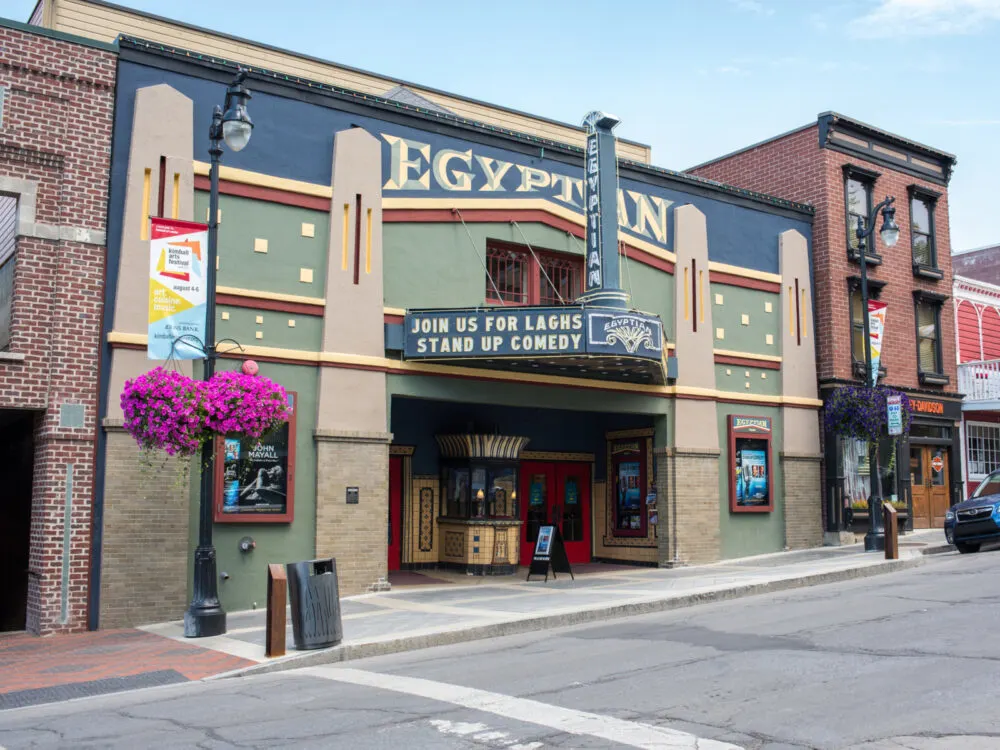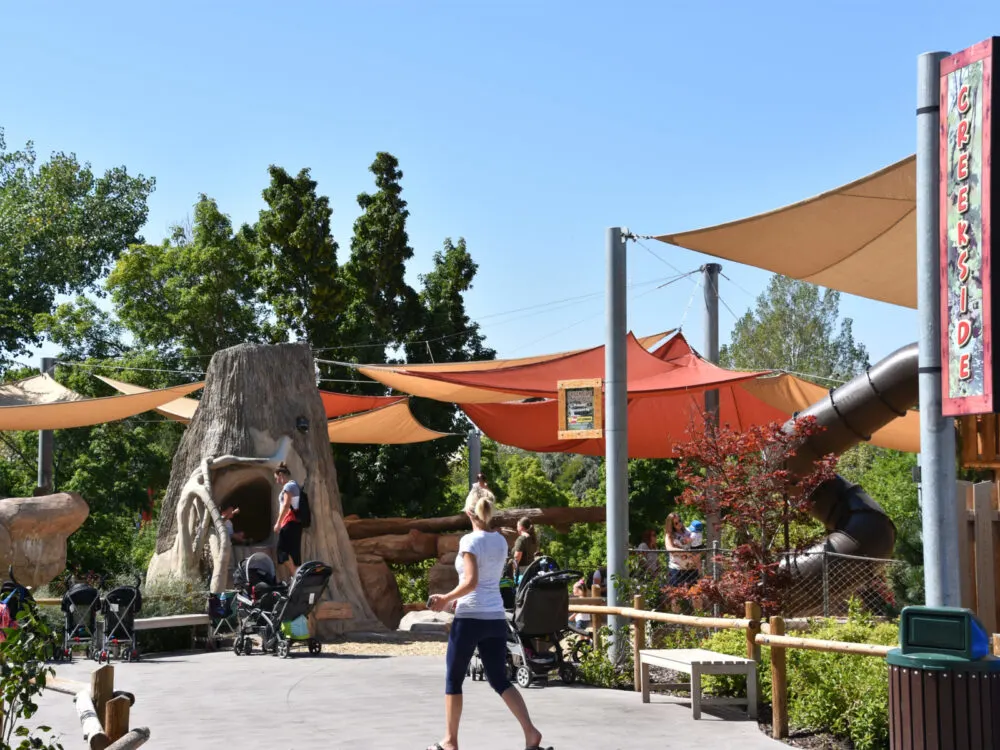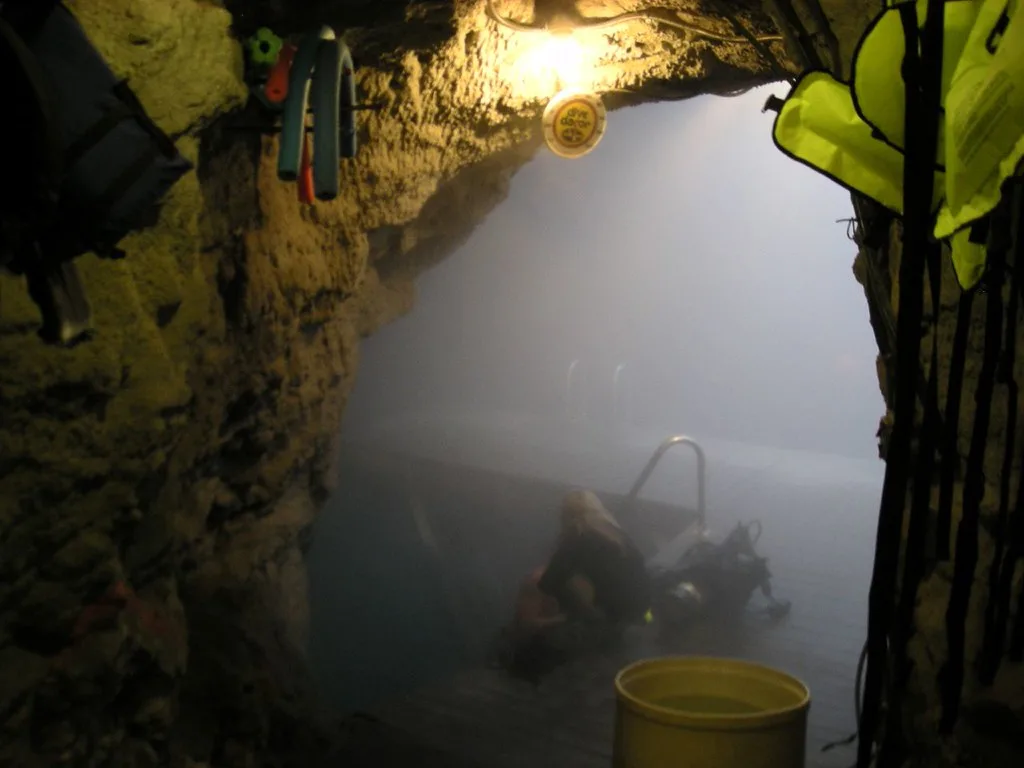Utah is a paradise for adventurers and people who love the outdoors and is full of national parks and gorgeous natural rock formations. From hiking trails to rock bridges, it has every wonder of the natural world visitors could hope to explore. We’ll show you the best places to visit in Utah below.
The 21 Best Places to Visit in Utah in 2025
The state offers a compelling mix of natural sites and cultural institutions that appeals to any traveler. We’ve compiled a list of the best locations in Utah to visit, representing everything from parks to museums to historical landmarks.
1. Zion National Park

Galyna Andrushko/Shutterstock
The Mormons named Zion National Park after the Hebrew word for Sanctuary, and once you experience the natural scenic beauty of the area, you will understand why.
Zion is 229 square miles of splendor and a hugely popular Utah attraction, drawing in 4.3 million annual visitors. Zion provides refuge to a menagerie of wildlife.
The park houses 79 varieties of mammals, 32 kinds of amphibians and reptiles, eight different sorts of fish, and 289 families of birds. Speaking of the avian inhabitants, Zion is a natural habitat of the California Condor.
These enormous, majestic birds became endangered in 1967 and are the largest North American flying birds. The park offers a wealth of experience to intrepid explorers, including:
- Zion Canyon: Zion Canyon is 2000 feet deep and traversable by car, and ideal for canyoneering.
- Zion Canyon Scenic Drive: The Zion Canyon Scenic Drive is a bus ride open to visitors.
- Zion-Mount Carmel Highway: Guide yourself through the park on the Zion-Mount Carmel Highway.
- Angel’s Landing Trail: The Angel’s Landing Trail is a challenging hike, over two and a half miles at 1500 feet elevation.
The best time to visit Zion is between April and November. July and September are Zion’s rainiest months, and temperatures run an extreme gamut.
Summer highs reach 100 degrees Fahrenheit, while winter weather can dip to negative twenty degrees at night. Plan to dedicate five to seven days for a full exploration of the park and take advantage of the free shuttle services Zion offers.
Read Next: When Should You Visit Zion National Park?
2. Park City

Sean Pavone/Shuttestock
Park City lies east of Salt Lake City and appeals to both outdoorsmen and those who prefer urban delights. Park City is home to the United States Ski Team and offers many slopes to skiing enthusiasts.
The High West Distillery & Saloon is the country’s only ski-in, ski-out distillery; athletes can get a drink without taking off their equipment. Outdoors-people who don’t enjoy skiing can bike the many trails in Park City.
The metropolis still carries the memories, and some of the equipment of the 2002 Olympics, including a museum and Comet Bobsled-a ride with 18 hairpin turns that lets riders feel like Olympic athletes.
Park City is a perfect mix of metropolitan and natural. Visitors can ski on the many slopes and dine in various restaurants. Make the most of your Park City visit by checking out both the wild and the cultural attractions.
3. Homestead Crater
The Homestead Crater is a natural geothermal spring located in Park City, hidden beneath 55 feet of limestone rock. Visitors can enjoy a wealth of outdoor activities at the 10,000-year-old natural wonder, including:
- Swim
- Snorkel
- Yoga on a paddleboard
- Scuba dive
- Therapeutic soak
4. Sundance Film Festival

Michael Gordon/Shutterstock
Founded by Robert Redford’s production company, the Sundance Film Festival is the country’s largest independent film festival. The event takes place over two weeks in January and is a massive draw for cinephiles worldwide.
5. Cedar Breaks National Monument

Oscity/Shutterstock
The local Native American population honored the rich, vibrant colors of Cedar Breaks National Monument by calling it “The Circle of Painted Rocks.”
Open between late May and mid-October, Cedar Breaks has an elevation of 10,000 feet, with a 2,000-foot drop to the base. The Monument offers hiking trails, notably:
- Alpine Pond Trail
- Spectra Point Overlook Trail
- Ramparts Overlook Trail
Visitors under sixteen years of age enjoy the park for free, while those over sixteen pay a seven dollar entrance fee to experience:
- Sightseeing
- Photography
- Hiking
- Picnicking and camping
- Cross country skiing
- Snowmobiling in the winter
6. Natural Bridges National Monument

Colin D. Young/Shutterstock
The National Bridges National Monument provides precisely what the name promises; several land bridges formed over the years. Visitors can experience the entire park in two to three hours, enjoying hiking trails and the beautiful landscape.
Located south of Canyonlands National Park, the three titular bridges are:
- Sipapu: Sipapu is the largest and most popular of the three bridges. The bridge spans 1.2 miles, with steep regions and natural ladders and stairs to explore.
- Kachina: Kachina offers a more leisurely hike to visitors and covers one and a half miles.
- Owachoma: Owachome is the smallest bridge and the easiest and shortest hike.
After exploring the bridges, check out the Horsecollar ruins. These houses are 700-year-old Native American building remnants.
7. Coral Pink Sand Dunes State Park

Marina Poushkina/Shutterstock
The unique and beautifully hued sands of Coral Pink Sand Dunes State Park are the eroded remnants of pink Navajo sandstone. The sand dunes move up to fifty feet annually, and visitors to the park enjoy:
- Sandboarding and Sand games
- ATV trails
- Camping
- Hiking
- Horseback riding
- Wildlife watching
- Photography
Coral Pink Sand Dunes State Park is open year-round.
8. Moab

Jnjphotos/Shutterstock
Moab City is a town conveniently located near Canyonlands National Park, Arches National Park, and Dead Horse Point State Park in southeast Utah. This mecca of natural beauty provides visitors with the opportunity to:
- Bike
- Hike
- Fast/kayak
- Off-road
- Slickrock trail hike
Moab’s many attractions focus heavily on outdoor activities, so visits are best in the spring and summer months and not great in the winter.
9. Arches National Park

tusharkloey/Shutterstock
Arches National Park has over 2000 natural stone arches. The full, scenic tour is a 36-mile round trip that allows visitors to enjoy such arches as:
- Delicate Arch: The largest free-standing arch in the park, the Delicate Arch stands at 46 feet high and 32 feet wide.
- Double Arch: “Indiana Jones and the Last Crusade” and “Thelma and Louise” were both filmed at the Double Arch, making the edifice a must-see for cinephiles.
- The Broken Arch: The Broken Arch is not, in fact, broken; it only appears to be. A strategically located crack fractures the arches facade.
- The Fiery Furnace: The Fiery Furnace is the central point of the park, named after the shade it turns at sundown. This area is hugely popular with hikers.
- Balanced Rock: Balanced Rock is 128 feet high, with a secondary rock balancing 55 feet above the base.
10. Canyonlands National Park

Scott Prokop/Shutterstock
While Canyonlands National Park is open year-round, it is best visited in the spring and the fall twenty-four hours a day. The desert gets extremely cold in the winter and incredibly hot in the summer.
So it’s not ideal for anyone with a standard tolerance to extreme temperatures. Canyonlands is divided into three districts:
- Island in the Sky: Island in the Sky has a paved scenic drive, water-carved canyons, and hiking trails. It is the most accessible district in the park.
- The Needles: The Needles are less accessible with strenuous hiking. Drivers require a four-wheel drive to traverse it.
- The Maze: The Maze is the most remote and challenging-to-reach district. Only seasoned outdoors people should brave the Maze.
11. Salt Lake City

f11photo/Shutterstock
Salt Lake City is the bustling center and beating heart of Utah. The state capital is located in the city, as is the Mormon Temple, an edifice only accessible to Mormons but still beautiful to view from the outside.
Salt Lake City has ten excellent ski resorts, national parks, and numerous monuments to Utah’s history.
12. Temple Square

Nagel Photography/Shutterstock
Temple Square is a 35-acre area rich in Mormon history and culture. The center is the home base of the Church of Jesus Christ of Latter-day Saints. Temple Square houses the Mormon Temple and Headquarters.
It took 40 years to complete construction on the Temple, located in the city’s heart. Temple Square is the most visited attraction in Utah, annually drawing in three to five million visitors from across the globe.
While the Temple is considered a sacred site that cannot be toured by the public, free tours of the grounds are available, as is a Pioneer History Walking Tour. Visitors also must check out:
- Family History Library: The Family History Library is the world’s largest genealogical repository, housing over 2.4 million microfilmed family research.
- Tabernacle Choir at Temple Square: The world-famous Tabernacle choir opens its rehearsals to the public on Thursdays. The 360 volunteers have performed internationally.
- Joseph Smith Memorial Building: The Joseph Smith Memorial Build stuns with a stained glass ceiling in the lobby. Previously the hotel in Utah, the building has fine dining options and a Legacy Theater with free film screenings.
- Church History Museum: The Church History Museum has interactive exhibits, including a 168-year-old log home. The museum also houses a 240-degree theater experience and hosts a rotating art collection.
Temple Square has two visitor centers, open from 9 am to 9 pm. Both provide free tours in numerous languages. The North Visitors Center has an 11-foot Christ statue.
At the same time, the South Visitors Center is more dedicated to church members and focuses on the history and development of the Salt Lake Temple. Even if you aren’t religious, it’s an incredible piece of architecture that anyone can enjoy.
13. The Great Salt Lake

Bella Bender/Shutterstock
The Great Salt Lake is the largest body of water west of the Mississippi River and is also one of the saltiest bodies of water in the world.
It has ten thousand miles of shoreline and the extreme salination of the water helps swimmers float while they enjoy spotting the local wildlife. The Great Salt Lake provides a habitat for:
- Bison
- Antelope
- Deer
- Bobcats
- Coyotes
- Elk
The lake is 72 miles long, 34 miles wide, and up to 33 feet deep, surrounded by 10,000 miles of shoreline. A quick, half-hour drive northwest from Salt Lake City, the Great Salt Lake used to be a part of Lake Bonneville but now offers visitors the chance to:
- Swim
- Sunbathe
- Kayak
14. Antelope Island State Park

Cheri Alguire/Shutterstock
Antelope Island State Park has clean beaches and a marina and offers visitors the chance to witness some of Utah’s wildlife, including:
- Antelopes
- Coyotes
- Sheep
- Waterbirds
- Bison
The 1848 Field Garr Ranch sits among the natural springs and mountains of Antelope Island State Park. Campers enjoy the scenery and can visit the visitors center.
15. Bonneville Salt Flats

Andriy Blokhin/Shutterstock
The Bonneville Salt Flats is open free to the public all year round. Located on the western boundary of the Great Salt Lake Basin, the flats cover 30,000 acres with a salty white crust. Visitors to the Salt Flats stand on 11,000 years of formation.
Read Next: The Best & Worst Times to Visit Bonneville Salt Flats in 2025
16. Hogle Zoo

Ritu Manoj Jethani/Shutterstock
Created in 1931, Hogle Zoo houses over 800 animals. The zoo covers 42 acres and is open daily, all year long. Visitors can interact directly with the animals, feeding giraffes and hanging out with rhinos.
There are a variety of daily educational programs, animal encounters, exhibits, and attractions you can visit such as the Conservation Carousel or the Lighthouse Point Splash Zone.
Read Next: Our Picks for the Best Zoos in the United States
17. Natural History Museum of Utah

Uladzik Kryhin/Shutterstock
The Natural History Museum of Utah houses the most extensive collection of horned dinosaur fossils in the world. In addition to a gift shop and in-house cafe, the museum has several different sections, including:
- Paleontology section: The paleontology section focuses on the Intermountain West.
- Anthropology Section: This section has 11,500 BC specimens.
- Botany section: The botany section holds a collection of frozen DNA.
- Zoology section: The zoology section has reptile, bird, mammal, and amphibian specimens.
- Entomology section: This section houses six continents of insect specimens.
- Malacology section: The malacology section has six marine mollusks classes.
- Mineralogy section: This section houses a worldwide minerals collection.
18. Grand Staircase-Escalante National Monument

Kojihirano/Shutterstock
The Grand Staircase-Escalante National Monument is named after its most extraordinary attraction-a stone staircase made of cliffs and drops.
The park is close to Paria, a town established in 1865 and abandoned in 1920. Several western movies were filmed in Paria, and Devil’s Garden is only a half-mile hike away.
The Monument became a national park in 1996 and is broken into three geographic sections:
- Grand Staircase: The Grand Staircase is made of descending cliffs, moving south from Bryce Canyon. The staircase is a veritable rainbow, comprised of Pink Cliffs, Grey Cliffs, White Cliffs, Vermillion Cliffs, and chocolate cliffs.
- Kaiparowits Plateau: Not for the acrophobic, Kaiparowits Plateau reaches 9,000 feet up, making it the highest point of the Monument. It is also the aridest and most remote location in the Grand Staircase-Escalante National Monument.
- Canyons of the Escalante: These canyons resulted after years of erosion from the Escalante River. The canyons are the most popular part of the Monument, full of active waterfalls, arches, and chiseled Slickrock.
19. Best Friends Animal Sanctuary

SSKH-Pictures/Shutterstock
Animal lovers can’t miss the Best Friends Animal Sanctuary. Founded in 1984, the Sanctuary is the largest no-kill shelter in the country.
Best Friends is located in Kanab, southern Utah, and provides a home to 1700 cats, dogs, horses, rabbits, and birds. Visitors may even leave with a new best friend; the Sanctuary offers adoptions.
Best Friends is the home to injured and special needs animals and is open between 8 am and 5 pm. The sprawling animal estate is divided into sections by animals. These areas are:
- Catworld
- Dogtown
- Horse Haven
- Bunny House
- Parrot Garden
- Piggy Paradise
- Wild Friends: Rehabilitation for the injured and orphaned
The Sanctuary has two beautiful outdoor areas to enjoy. These are:
- Angel Rest: Angel Rest is not your conventional pet cemetery. Spacious and serene, Angel Rest is ornamented with windchimes honoring the passed animals of Best Friends. Guided tours are provided, and animal blessings are offered monthly.
- Gratitude Garden: The Gratitude Garden is a yawning, gasping breath of fresh air, stretching through aromatic gardens. Wander through the Garden’s labyrinth and enjoy the canyon during regular sanctuary hours.
Best Friends provides access to pet-friendly hiking trails. Check out:
- Hidden Lake: Hidden Lake trail is ATV friendly, so be on the lookout. However, the path is worth it as it leads to a beautiful aquatic cave.
- Angels Overlook: The Angels Overlook hike leads to lunch, and what could be better than that? A one-point five-mile round-trip, Angels Overlook is a challenging trail with many up and downhills.
Frequently Asked Questions

tusharkoley/Shutterstock
Here are some frequently asked questions about Utah:
What is the top attraction in Utah?
Zion National Park tops the list of Utah’s many attractions. The area’s natural beauty and hiking trails draw visitors from all over.
What is the best time of year to visit Utah?
Utah’s temperatures are most moderate between April through May and September. These periods pull smaller crowds and much of the vegetation blossoms in these seasons.
What is the state food of Utah?
Utah offers plenty of attractive fine dining options. However, the state food is Jello. Jello’s popularity is bound to the Mormons; it’s beloved at large community gatherings.
Why is Utah so popular?
Utah is full of natural beauty and historical importance. The citizens are very friendly to each other and outsiders, making it a well-loved tourist location.
What is Utah’s nickname?
Utah’s nicknamed The Beehive State. The nickname has no connection to the state’s relationship with bees; Utah chose the bee because of its diligence and hard work.
Best Places to Visit in Utah: Final Thoughts
Utah is rampant with natural wonder. Plan your travels carefully to experience as many parks and natural wonders as possible. Utah has something for everyone; the museums and historic sites represent the culture and history of a fascinating state. Happy travels!




